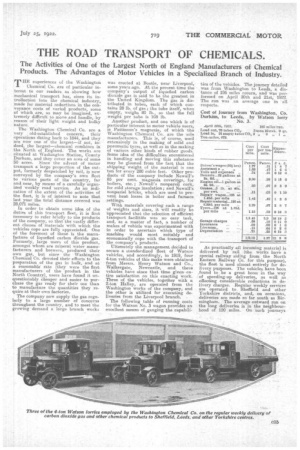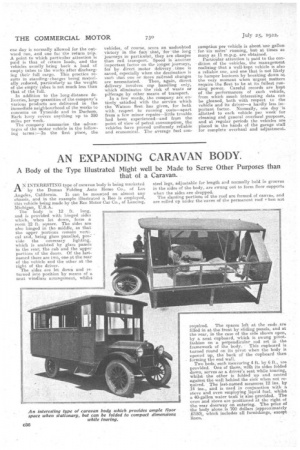THE ROAD TRANSPORT OF CHEMICALS.
Page 17

Page 18

If you've noticed an error in this article please click here to report it so we can fix it.
The Activities of One of the Largest North of England Manufacturers of Chemical Products. The Advantages of Motor Vehicles in a Specialized Branch of Industry.
THE experiences of the Washington Chemical Co. are of particular interest to our readers as showing bow mechanical transport has, since its introduction into the chemical industry, made for material reductions in the conveyance costs of varied products, some of which are, as may be imagined, extremely difficult to move and handle, by reason of their light weight and bulky nature.
The Washington Chemical Co. are a very old-established concern, their operations dating back to 1844, and they are now one of the largest-if not, indeed, the largest-chemical combines in the North of England: The works are situated at Washington Station, County Durham, and they cover an area of some 50 acres. Since the advent of motor transport a large proportion of the output, formerly despatched by rail, is now conveyed by the company's own fleet to various parts of the country, far and near, by means of a carefully organited weekly road service. As an indication of the extent of the activities of the fleet, it is of interest to note that last year the total distance covered was 28,071 miles.
In order to obtain some idea of the duties of this transport fleet, it is first necessary to refer briefly to the products of the company, so that the vastly different classes of materials with which the vehicles cope are fully appreciated. One of the foremost of these is the manufacture of liquefied carbon dioxide gas. Formerly, large users of this product, amongst whom are mineral water manufacturers and brewers, produced their own gas, but since the Washington Chemical Co. devoted their efforts to the preparation of the gas in bulk, and at a reasonable sate (they were the first manufacturers of the product in the North Country), users have found it unquestionably cheaper and easier to purchase the gas ready for their use than to manufacture the quantities they require at their own factories.
The company now supply the gas regularly to a large number of concerns throughout the country, and to meet" the growing demand a large branch works was erected at Bootle, near Liverpool, some years.ago. A. the present time the company's output of liquefied carbon dioxide gas is said to be the greatest in the United Kingdom. The gas is distributed in tubes, each of which contains 28 lb. of gas ; the tube itself, when empty, weighs 80 lb., so that the full weight per tube is 108 lb.
Another product, and one which is of particular interest to motor vehicle users, is Pattinson's magnesia' of which the Washington Chemical Co. are the sole manufacturers. This is, of course, used extensively in the making of solid and pneumatic tyres, as well as in the making of various other kinds of rubber goods. Some idea of the difficulties encountered in handling and moving this substance may be gleaned from the fact that the shipping weight of the material is one ton for every 280 cubic feet. Other productsof the company include Newell's 85 per cent, magnesia coverings, for boilers, etc.; Newall's nonpareil cork, for cold storage insulation; and Newell's nonpariel bricks, which are used to prevent heat losses in boiler and furnace settings.
With materials covering such a range of weights and sizes, it will readily be appreciated that, the selection of efficient transport facilities was no easy task, and, as a matter of fact, a number of makes of vehicle was experimented with in order to ascertain which type of machine would most suitably and economically cope with the transport of the company's products. Ultimately the management decided to secure a standardized fleet of Watson vehicles, and accordingly, in 1919, four 4-ton vehicles of this make were obtained from Messrs. Henry Watson and Co., Walkergate, Newcastle, and these vehicles have since that time given entire satisfaction on this exacting work. Three of the vehicles, together with a 2-ton Halley, are operated from the Washington works of the company, and the other is utilized for executing deliveries from the Liverpool branch.
The following table of running costs for the Watson No. 3 wagon provides an excellent means of gauging the capabili
ties of the vehicles. The journey detailed was from Washington to Leeds, a distance of 105 miles return, and was performed on April 20th and 21st, 1922. The run was an average one in all respects.
Cost of Journey from Washington, Co. Durham, to Leeds, by Watson lorry • No. 3.
April 20t5, 1922. 1115 miles run.
Load out, '70 tubes COI 3 tons 10 cwt. 0 qr. Load in, 91 empty tubes CC) „ 8 „ 1 „ Ton-miles, 072,
As practically all incoming material is delivered by rail (the works have a special railway siding from the North Eastern Railway Co. for this purpose), the fleet is used almost entirely for delivery purposes. The vehicles have been ,found to be a great boon in the way :of speeding-up deliveries, as well as effecting considerable reductions in delivery charges. Regular weekly services are operated to Sheffield and other Yorkshire districts, and, on occasions, deliveries are made so far south as Birmingham. The average outward run on the long deliveries is in the neighbourhead of 120 miles. On such journeys one day is normally allowed for the outward run, and one for the return trip. A point to which particular attention is paid is that of return loads, and the vehicles usually bring back a load of empty tubes to the works after discharging their full cargo. This practice results in standing/ chargesbeing materially reduced, particularly as the weight of the empty tubes is not much less than that of the full.
In addition to the long-distance deliveries, large quantities of the company's various products are delivered in the immediate neighbourhood of the works to concerns on Tyneside and in Durham. Each lorry covers anything up to 350 miles per week.
The company Summarize the -advantages of the motor vehicle in the follow ing terms the first place, the
vehicles, of course, score an undoubted victory in the fget, -that, for -the long journeys in particular, they are cheaper than rail transport. Speed is another important factor on the longer journeys, for by direct motor delivery time is saved, especially when the destination is such that, one or More railroad changes
are necessitated. Then, again, direct delivery involves on handling only, which eliminates the risk of waste or pilferage by other means of transport.
In a few words, the company are entirely satisfied with the service which the Watson fleet has given, for both with respect to running costs—apart from a few miner repairs—little trouble had been experienced—and from the point of view of petrol consumption, the vehicles have proved uniformly reliable nod economical. The average fuel con sumption per vehicle is about one gallon for--six miles' running, hut at, times as many as 11 m.p.g. are obtained. Particular attention is paid to the condition of the vehicles, the management realizing-that a well-kept vehicle is also a reliable one, and one that is not likely to hamper business by breaking down at the very moment when urgent matters require the fleet to be at its fullest running power. Careful records are kept of the performances of each vehicle, from which much interesting data can be gleaned, both with respect to the vehicle and its driver—a hardly less important factor. Normally, one day -is allottedto each vehicle per week for cleaning and general overhaul purposes, and at regular periods the vehicles are placed in the hands of the garage staff for complete overhaul and adjustment.






























